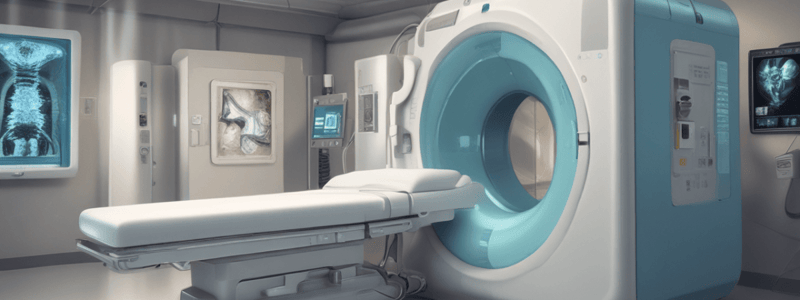Podcast
Questions and Answers
What is a key difference in the thermal loads experienced by x-ray tubes in CT scanners compared to other diagnostic x-ray applications?
What is a key difference in the thermal loads experienced by x-ray tubes in CT scanners compared to other diagnostic x-ray applications?
- No thermal loads in CT
- Higher thermal loads in CT (correct)
- Similar thermal loads in CT and other applications
- Lower thermal loads in CT
Why did early CT scanners not require high-power x-ray tubes?
Why did early CT scanners not require high-power x-ray tubes?
- Due to the use of ceramic insulators
- Due to low power levels (correct)
- Due to high scan times
- Due to the use of oil-cooled rotating anodes
What was the result of the introduction of helical CT with continuous scanner rotation?
What was the result of the introduction of helical CT with continuous scanner rotation?
- The need for oil-cooled rotating anodes was eliminated
- Scan times decreased further
- New demands were placed on x-ray tubes (correct)
- Lower power levels were required
What has been the result of advancements in anode design?
What has been the result of advancements in anode design?
What is the purpose of thick graphite backing of target disks in modern x-ray tubes?
What is the purpose of thick graphite backing of target disks in modern x-ray tubes?
What is the range of heat units available in modern x-ray tubes?
What is the range of heat units available in modern x-ray tubes?
Study Notes
High Power X-ray Tubes in CT Scanners
- X-ray tubes in CT scanners are subjected to higher thermal loads compared to other diagnostic x-ray applications.
- Early CT scanners had low power levels, allowing heat dissipation during long scan times.
- Later CT scanners required high-power x-ray tubes and oil-cooled rotating anodes for efficient thermal dissipation due to shorter scan times.
- Helical CT with continuous scanner rotation introduced new demands on X-ray tubes, leading to technical advances in component design.
- Advances in tube envelope, cathode assembly, and anode assemblies (including anode rotation and target design) have enabled high-power x-ray tubes.
- Anode heat capacities have increased by up to five times, preventing the need for cooling delays during most clinical procedures.
- X-ray tubes with capacities of 5–8 million heat units are available, and heat storage capacity has increased.
- Thick graphite backing of target disks, anode diameters of 200 mm or more, and improved high-temperature rotor bearings have contributed to large heat capacities.
- Metal housings with ceramic insulators have also improved heat storage capacity.
Studying That Suits You
Use AI to generate personalized quizzes and flashcards to suit your learning preferences.
Description
This quiz explores the evolution of X-ray tubes in CT scanners, from low-power to high-power tubes, and the technological advancements made to dissipate heat efficiently.




